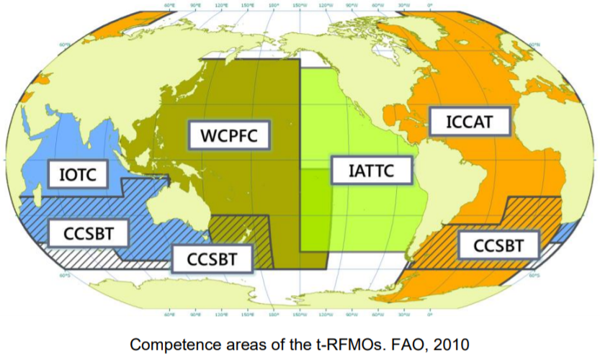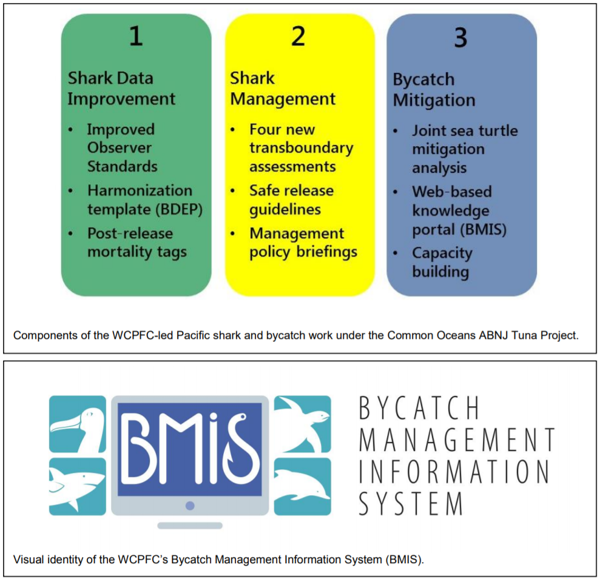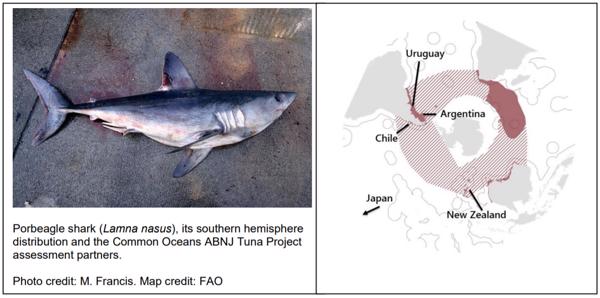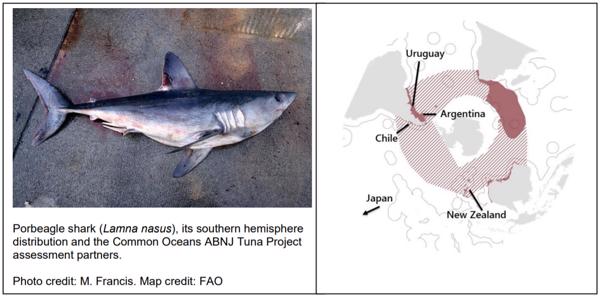
Mainstreaming the Management and Conservation of Sharks and Bycatch in Pacific High Seas Tuna Fisheries
The world's tuna fleet, comprising thousands of vessels from over 85 countries landing catches valued at >10 billion USD annually, is a critical global food source. But these fisheries are a major cause of mortality for some populations of seabirds, sea turtles, marine mammals and sharks and can pose a major threat to biodiversity conservation. This project was designed to address bycatch issues by identifying and implementing better assessment, management and mitigation practices for sharks and sea turtles in the Pacific. Challenges addressed included lack of information as a pretext for inaction, jurisdictional issues preventing a comprehensive approach, data access restrictions, and analytical obstacles arising from data quantity and quality shortfalls. Replication within other large international resource management organizations should be possible with creative adaptation of approaches to suit new and different conditions. This experience demonstrates some successes for regional cooperation in developing building blocks for transboundary wildlife management.
Many of the world’s most valuable fisheries and marine ecosystems are integrally dependent on Areas Beyond National Jurisdiction (ABNJ), commonly referred to as the high seas. Five tuna Regional Fisheries Management Organizations (tRFMOs) are responsible for ensuring the sustainable use, conservation and management of these tuna fisheries within their respective area of competence (see map below). The five-year multi-stakeholder Common Oceans ABNJ Tuna Project implemented by the Food and Agriculture Organization of the United Nations (FAO) aims at achieving efficiency and sustainability in tuna production and biodiversity conservation in the ABNJ. This Project harnesses the efforts of a large and diverse array of partners, including the five tuna Regional Fisheries Management Organizations, governments, inter-governmental organizations, non-governmental organizations and private sector. Alongside tuna, the ABNJ is also home to other ecologically important and economically valuable species frequently caught as ‘non-target’ or incidental catch, commonly referred to as bycatch. Purse seine and pelagic longline fisheries, the two primary gear types for catching tunas, are a major cause of mortality for some populations of seabirds, sea turtles, marine mammals and sharks and can pose a major threat to biodiversity conservation. Over time depletion of populations which cannot rebuild quickly due to low reproductive rates or other constraints can undermine the integrity of the ecosystem itself through cumulative, adverse impacts on trophic structure and processes.
At one end of the spectrum of bycatch species are the sharks, a valuable food resource in some fisheries and an unwanted by-product in others. In both cases, the need to manage catches within sustainable limits is urgent but hampered by a lack of available catch, trade and biological data. Concerns about shark populations have led to recent requirements under the Convention on International Trade in Endangered Species (CITES) for trade permits but this only heightens the need for fisheries management as a basis for determining what levels of trade are permissible. Sea turtle species are somewhat different from sharks in that no longline or purse seine fisheries target them, and most will discard them if accidentally caught. Even so, interaction with fishing gear, which can lead to asphyxiation, entanglement lacerations and infections, or starvation is one of the most serious threats to their survival. Of seven species of sea turtle, six are threatened with extinction according to the IUCN Red List and all have been listed by CITES for several decades.
One component of the Common Oceans ABNJ Tuna Project was designed to address bycatch issues by identifying and implementing better assessment, management and mitigation practices. Work led by the Western and Central Pacific Fisheries Commission (WCPFC) has focused on sharks and sea turtles in the Pacific and is described in this Experience Note. Additional bycatch-related projects have been undertaken by other project partners. The WCPFC activities were designed to: 1) identify the data deficiencies that make shark management challenging and propose strategies to obtain more data through field studies and better information return from fisheries (Shark Data Improvement); 2) identify risks and priorities for shark conservation through new assessment tools and a strengthened management framework by the t-RFMOs (Shark Management); and 3) collate and generate new information to mitigate impacts on bycatch species allowing t-RFMO discussions to focus on management issues such as cost and feasibility (Bycatch Mitigation).
| Meta data | |
|---|---|
| Regions | Global |
| Scope | Global |
| Ecosystem | Sea |
| Categories | ABNJ |
| Thematic | Biodiversity , Fisheries , Marine Ecosystems , Transboundary |
The first of several challenges faced by the project was the tendency of some parties to use the lack of information as a pretext for postponing management decisions. In the context of bycatch, urgent action is needed to reduce the collateral damage of fishing operations to threatened, non-target species. Some fisheries are currently using streamer lines that deter seabirds, leader materials that allow sharks to bite through, and baits and hooks that are less likely to attract and injure sea turtles. Nevertheless, questions about how well these mitigation measures work in practice, and whether the mortality rates are low enough to allow bycatch populations to be sustained, continue to be raised whenever management is discussed. The vision of the project was to compile existing information in an engaging and easilyupdated format that would allow users--ranging from scientists to managers to fishers to the general public—to explore management options for themselves. The goal was to dispel generalities about insufficient information and promote a focus on resolving the true areas of uncertainty.
The second challenge related to a reluctance to engage in important issues whose scope appears broader than the mandate of the involved organizations. This is a frequent occurrence when working with highly migratory species occurring in the ABNJ, and is particularly apparent when considering the arbitrary boundary between the Eastern and Western Pacific t-RFMOs. Beyond such geographical issues, scoping problems may arise when the fishery is responsible for only some of the impacts on the threatened population. This is the case with sea turtles (and seabirds) which not only suffer from fishing gear interactions but also face terrestrial habitat degradation, egg predation and marine pollution impacts. Grounded in the t-RFMO mandate to manage fisheries, the project would find it difficult to tackle cumulative impacts from other sources but has attempted to address cross-boundary issues by designing shark and sea turtle work on a Pacific-wide basis. The vision of the project was for WCPFC to collaborate with the t-RFMO for the Eastern Pacific (the Inter-American Tropical Tuna Commission, IATTC) for its studies of bigeye thresher shark, porbeagle shark and leatherback, loggerhead, olive ridley and green sea turtles. The goal was to produce regional results that could form the basis for consistent management actions on both sides of the ocean basin.
The third challenge pertained to the practical matter of data access. One of the limitations often encountered when discussing bycatch within the t-RFMOs is that the data necessary to address the questions are not accessible to analysts. This is sometimes due to the fact that the t-RFMO data provision rules require member countries only to submit data relating to target species. Another impediment arises when the t-RFMO does not maintain a regional database and instead relies on member countries to analyze their own data and to submit the results. This approach does not facilitate an integrated assessment of wide-ranging species. Finally, regardless of where data may be held, confidentiality rules may prohibit the sharing of data amongst member countries or t-RFMO Secretariats. The vision of the project was to find ways to not only allow independently held datasets to be composited, but also to allow the analysis itself to be conducted in a joint and interactive manner. The goal was to benefit from each participant's specific knowledge of their own fishery and build support for the outcome through a collaborative process.
The fourth challenge is that bycatch analyses are almost always severely constrained by the quantity and quality of data. This issue arises from an historical dearth of attention to bycatch due to both its lack of commercial value and a failure to appreciate the long-term consequences of population and ecosystem collapse. In the most severe cases the futility of bycatch analysis cannot be denied, but it is also true that the severity of the threat to bycatch requires action both on data improvement initiatives and on the development of new methods for data-poor species. The vision of the project was to improve bycatch data standards to ensure the proper information content to support analyses, and to encourage innovative assessments for species which have been passed over due to data gaps. At the same time, the goal was to elevate the profile of bycatch data in order to establish it as part of the core business of the t-RFMOs.
The project addressed the first challenge of lack of information as a reason for inaction by launching a web portal for exploring past and present efforts to tackle critical bycatch issues. The Bycatch Management Information System (BMIS) offers an engaging interface for over 1700 curated references including species identification and safe release guides, a Twitter account and a built-in blog. Since its release in May 2017, the system has been seen by 9,400 users who have viewed more than 37,300 pages. It now appears at the top of the results for ‘bycatch management’ and ‘bycatch mitigation’ in the 3 major internet search engines. There were few technical problems associated with the development of the system architecture, but securing ongoing funding for its update and hosting/maintenance may be an issue, especially as the body of literature grows. Putting the tool into action, the project used the BMIS as the basis for a training workshop in May 2018 to prepare WCPFC member country representatives for an upcoming management discussion on sea turtle and seabird mitigation. In its annual meeting later that year, WCPFC members adopted a new sea turtle management measure applying mitigation requirements much more broadly across the fleets. Members also approved a new seabird mitigation technology that was analyzed in the BMIS training session. There will continue to be issues for which data and experience are lacking and it must be recognized that BMIS can highlight, but not fill, those gaps.
Nevertheless, compiling, distilling and disseminating what is known is a necessary first step along a long road toward effective management of biodiversity.
The second challenge was to overcome jurisdictional issues that discourage a comprehensive solution. The project was successful in conducting a southern hemisphere porbeagle shark assessment. This assessment was the first ever global shark assessment but as such required forging links with a number of different countries which had not previously worked together and are not members of the two sponsoring t-RFMOs (WCPFC and the Commission for the Conservation of Southern Bluefin Tuna (CCSBT)). Collaboration was spurred by the listing of this species by CITES and was facilitated by analysts able to travel to countries as varied as Chile and Japan to assist with national analyses.
Other assessments, though successfully completed, were not able to achieve full collaboration across the entire species' range. In the case of the bigeye thresher, data were made available by Japan in the Eastern Pacific high seas, but not from Central or South American countries. IATTC does not hold any of these data but has now embarked on data gathering exercises in some of the relevant Central American countries. For sea turtles, IATTC holds data but was unable to make it available due to confidentiality restrictions. To some extent it is difficult to separate these jurisdictional issues from those of data access and data quality, but it is clear that for the sake of migratory bycatch species better integration of management systems for the Western and Eastern Pacific tuna fisheries is desirable.
The third challenge involved securing access to data held under confidentiality restrictions. The project's greatest success in this regard was the joint analysis of sea turtle mitigation effectiveness convened by the WCPFC and the Pacific Community (SPC). This series of two workshops brought together representatives from 21 countries and organizations, many of which contributed confidential data for use in the workshop sessions only. To protect data confidentiality, data access was restricted to SPC scientists, who played the crucial roles of real-time data manager and analyst. Participants worked their way through models and maps estimating the likelihood of sea turtle catch and mortality using different combinations of longline gear, with SPC producing results and continuously revising products to reflect discussions. By the end of the workshops when data access permissions expired participants had produced findings on which mitigation techniques were most effective. Less effective but eventually successful solutions were found for the bigeye thresher and silky shark assessments in the form of obtaining data access for one analyst as a kind of "honest broker" who then acted as an interface to share data products, rather than raw data, with other analysts. Data confidentiality rules can be a hot button ssue for many, but by finding opportunities for analysis while demonstrating that confidentiality can be maintained, more flexible working practices--still within the rules--can be identified.
The fourth challenge related to the major data quality and quantity issues that impede bycatch analyses and thus bycatch management. A previous shark research plan for the WCPFC had concluded that porbeagle and bigeye thresher sharks could not be assessed due to data gaps, but through this project new approaches were developed that allowed these assessments to proceed and receive the endorsement of the WCPFC Scientific Committee. Efforts to develop data-poor methods must continue, in particular as some areas, e.g. shark “sanctuaries”, have stopped reporting shark catches altogether (while continuing to fish) suggesting that data-poor conditions will remain for some time. Data improvement work will take time to bear fruit, particularly because in the t-RFMOs all members must agree to any proposed change. Even once data begin to flow, short time series are not useful indicators of trends. A five-year project can thus only begin to institute better data collection and data management practices, and realizing results in future years will require patience as well as ongoing support. Further opportunities should be sought to publicize how improved data in combination with new techniques can lead to more informed management in order to reinforce this virtuous cycle. For this reason, the temptation to wait for better data before attempting analysis must be resisted.
Replication within other fisheries or large international resource management organizations should be possible with creative adaptation of approaches to suit new and different conditions. The importance of commitment, persistence and inventiveness should not be under-estimated when dealing with systems that are required to balance the competing interests of member States, particularly when falling back on status quo practices is often the easiest course of action.
Although many of the issues confronted in this component were similar to those in a seabird bycatch component of the project, there was little synergistic interaction between the two workstreams. This is probably due to the lack of a bycatch coordination role within the project management structure and the tRFMO-led work described in this Experience Note versus NGO-led seabird mitigation work. Embedding project staff within the regional management body (in this case the t-RFMO) proved highly effective and should be replicated whenever possible.
From the outset the ABNJ Tuna Project was designed to make a small, focused investment pay a large dividend over the long-term. Some of the shark and bycatch activities produced finished products, such as the shark assessments or BMIS tool, whereas others, such as data improvement efforts, aimed at initiating steps that can lead to significant incremental progress over time.
The most tangible success of the Project is the uptake of shark, sea turtle and seabird mitigation measures by the fishery management body (tRFMO). Management frameworks evolve slowly but the building blocks produced by the Project will continue to contribute to managing bycatch in a sustainable manner for many years to come.
In addition to generating a number of fisheries-specific methodological advances, cross-jurisdictional partnerships and data-sharing arrangements, the Project also produced successful models applicable to a range of transboundary wildlife management situations.
- Shelley Clarke (shelley.clarke@fao.org)
- Alejandro Anganuzzi (alejandro.anganuzzi@fao.org)





























